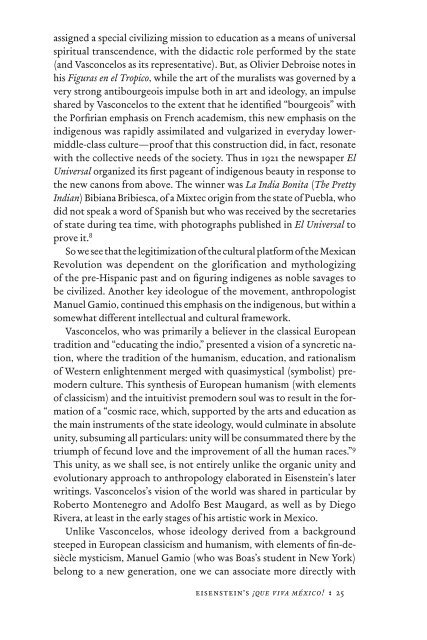In Excess: Sergei Eisentein's Mexico - Cineclub
In Excess: Sergei Eisentein's Mexico - Cineclub
In Excess: Sergei Eisentein's Mexico - Cineclub
You also want an ePaper? Increase the reach of your titles
YUMPU automatically turns print PDFs into web optimized ePapers that Google loves.
assigned a special civilizing mission to education as a means of universal<br />
spiritual transcendence, with the didactic role performed by the state<br />
(and Vasconcelos as its representative). But, as Olivier Debroise notes in<br />
his Figuras en el Tropico, while the art of the muralists was governed by a<br />
very strong antibourgeois impulse both in art and ideology, an impulse<br />
shared by Vasconcelos to the extent that he identifi ed “bourgeois” with<br />
the Porfi rian emphasis on French academism, this new emphasis on the<br />
indigenous was rapidly assimilated and vulgarized in everyday lowermiddle-class<br />
culture—proof that this construction did, in fact, resonate<br />
with the collective needs of the society. Thus in 1921 the newspaper El<br />
Universal organized its fi rst pageant of indigenous beauty in response to<br />
the new canons from above. The winner was La <strong>In</strong>dia Bonita (The Pretty<br />
<strong>In</strong>dian) Bibiana Bribiesca, of a Mixtec origin from the state of Puebla, who<br />
did not speak a word of Spanish but who was received by the secretaries<br />
of state during tea time, with photographs published in El Universal to<br />
prove it. 8<br />
So we see that the legitimization of the cultural platform of the Mexican<br />
Revolution was dependent on the glorification and mythologizing<br />
of the pre-Hispanic past and on fi guring indigenes as noble savages to<br />
be civilized. Another key ideologue of the movement, anthropologist<br />
Manuel Gamio, continued this emphasis on the indigenous, but within a<br />
somewhat different intellectual and cultural framework.<br />
Vasconcelos, who was primarily a believer in the classical European<br />
tradition and “educating the indio,” presented a vision of a syncretic nation,<br />
where the tradition of the humanism, education, and rationalism<br />
of Western enlightenment merged with quasimystical (symbolist) premodern<br />
culture. This synthesis of European humanism (with elements<br />
of classicism) and the intuitivist premodern soul was to result in the formation<br />
of a “cosmic race, which, supported by the arts and education as<br />
the main instruments of the state ideology, would culminate in absolute<br />
unity, subsuming all particulars: unity will be consummated there by the<br />
triumph of fecund love and the improvement of all the human races.” 9<br />
This unity, as we shall see, is not entirely unlike the organic unity and<br />
evolutionary approach to anthropology elaborated in Eisenstein’s later<br />
writings. Vasconcelos’s vision of the world was shared in particular by<br />
Roberto Montenegro and Adolfo Best Maugard, as well as by Diego<br />
Rivera, at least in the early stages of his artistic work in <strong>Mexico</strong>.<br />
Unlike Vasconcelos, whose ideology derived from a background<br />
steeped in European classicism and humanism, with elements of fi n-desiècle<br />
mysticism, Manuel Gamio (who was Boas’s student in New York)<br />
belong to a new generation, one we can associate more directly with<br />
eisenstein’s ¡que viva méxico! : 25


